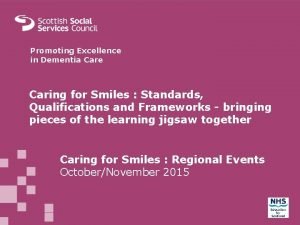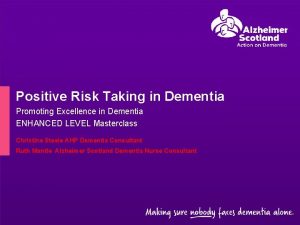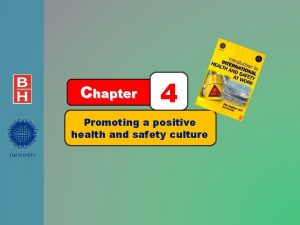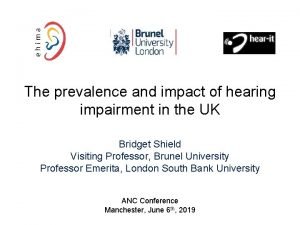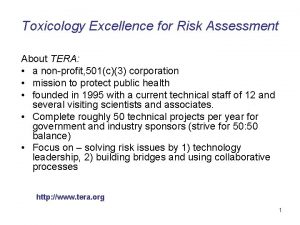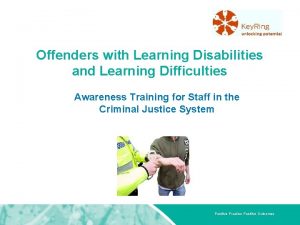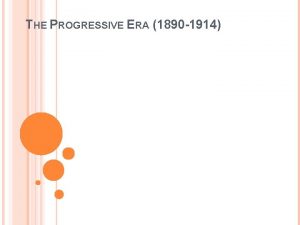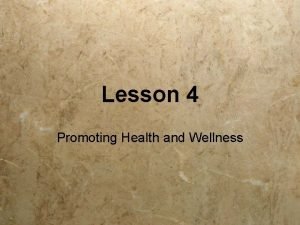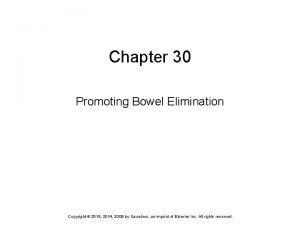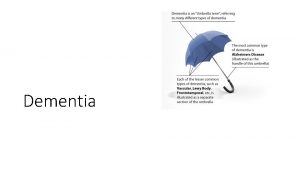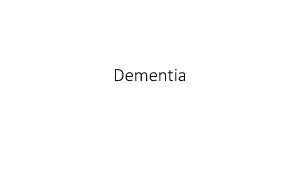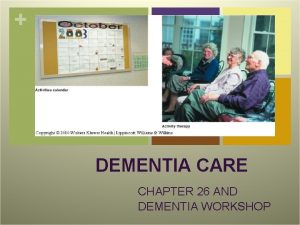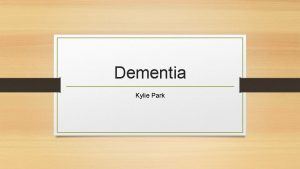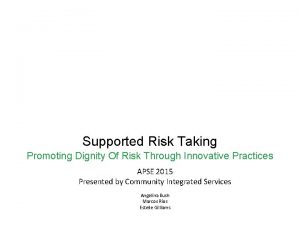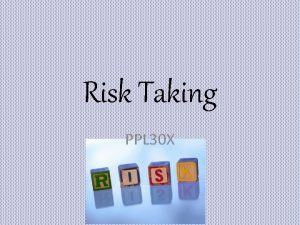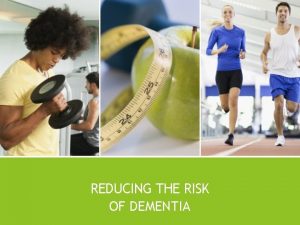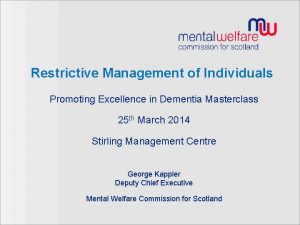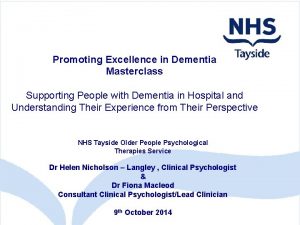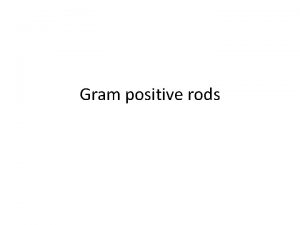Positive Risk Taking in Dementia Promoting Excellence in























- Slides: 23

Positive Risk Taking in Dementia Promoting Excellence in Dementia ENHANCED LEVEL Masterclass Christine Steele AHP Dementia Consultant Ruth Mantle Alzheimer Scotland Dementia Nurse Consultant

Aims: • Investigate the factors which influence our approach to risk • Review up-to-date research/ literature in relation to positive risk taking & dementia • Explore methods for integrating positive risk taking within your current practice.

What do we mean by risk and what is our experience in the workplace of risk and dementia? Case-studies

Definition of Risk Originates from Italian word risicare means ‘to dare’. Historically considered to be more about choice rather than fate. Today seen more as, ‘the possibility of incurring misfortune or loss’ and to expose to danger or loss’ Collins, 1998

“The only thing we have to fear, is fear itself” Franklin Roosevelt

Our perceptions and understanding of risk are shaped by: ‒ Society ‒ Cultures we work in ‒ Own personal narratives ‒ Values and life experience ‒ which in turn influences what we then consider being risky or acceptable levels of risk and shapes the way we respond’. Douglas & Wildavsky, 1982

Risk Perspectives ‒ Professionals- focus on management strategies on future and emphasize the physical domain of risk i. e. falls ‒ Family/ carers- focus on present and emphasise interpersonal domain of risk i. e. loss of partner role ‒ Person living with dementia- concerned with biographical domain i. e. loss of self-identity

Practitioner Role in Risk Management ‒ Hazard Manager- identify hazards and remove or minimise threat to cause harm. ‒ Risk Facilitator- identifying and supporting activities which add to the quality of life of someone. ‒ Dilemma Negotiator- identify and reconcile differing views and seek consensus between person living with dementia, family and practitioners. Alaszewki et al 1998

Consider role we might play in discharge planning? How might we influence decisions about discharge destination and be a dilemma facilitator or risk facilitator rather than a hazard manager?

‘Whilst physical safety remains key focus for healthcare, the ability to maintain self-identity and key relationships is of more importance to the person with dementia and their family’ Gilmour et. al, 2003

Physical Domain of Risk ‒ ‘probability of risk can be calculated as an objective measurement of the likelihood of harm occuring (Denney, 2005) ‒ Standardises and objectifies risk through use of risk matrices

Traditional risk discussions focus on downside risk Risk that an event will turn out worse than expected ‒ If person goes outside, what are the chances he will get lost, or walk into traffic? ‒ If he walks unassisted, what are the chances he will fall and be injured? ‒ At a social event, what are the chances she will be overwhelmed and distressed by the environment? Thomas & Ronch

Upside risk that an event will turn out better than expected. ‒ If person goes outside, what are the chances he will improve his conditioning and overall mood and sleep better at night? ‒ If he walks unassisted, could it improve his balance and lead to greater independence with other activities of daily living? ‒ If she goes to a social event, could it bring meaning, growth and forestall further cognitive decline?

Focusing on Physical Domain of Risk can lead to: ‒ Tick-box mentality that replaces clinical judgement ‒ Tells you very little about person ‒ Format is often negative in focus with little room for optimism or potential for working alongside risks or to take risks ‒ Managing and avoiding risk ‒ Doesn’t always show reason for risk

Silent Harms ‘often unintentional, that arise from emotional, psychological or spiritual neglect’ Clarke et al, 2011 The psychological and emotional risks can remain hidden and in just focusing on the physical domain of risk there is the danger that the person is denied the opportunity to make meaningful choices and to maintain a level of independence or autonomy.

Not being given the opportunity to undertake such basic activities as going to the toilet, leaving the ward/ home or walking unaccompanied because others do not believe the person to be capable of managing the potential risk involved can further deprive the person of their sense of identity and purpose. Can lead to feelings of disempowerment and hopelessness leading to deskilling and deterioration in person’s physical and cognitive functioning.

Understanding that stress and distress in dementia might in fact be the person communicating an unmet need or a reaction to a silent harm. . . . Can help prevent it being as perceived as risky behaviour but rather as a response to their reality at that moment and staff to consider if there is anything that can be done to meet that need.

Place at the centre of decision-making the person (who happens to have dementia) rather than the dementia (which happens to be part of the person) ‘Do not let someone’s past and future life be overshadowed by dementia’ Sabat, 2011

Move from thinking just about person being vulnerable (and so needing to manage their risks and harms) to understanding that it is a situation which leads to someone being vulnerable- so see the person as part of the context of situation.

Negotiating Risk Negotiating risk is neither the elimination of any activity that might produce a downside nor an acceptance of all activities without boundaries…… It is a conversation about who the person is and asks: ‒ how they stand to benefit from engaging in an activity? ‒ what the downside risks are? ‒ can they be mitigated to an acceptable degree of support? Power, 2014

‘Think not so much about protecting someone and avoiding risks, but getting to know what risks it is reasonable to enable someone to take in order to achieve a sense of achievement and purpose’. Clarke, 2014

Supporting positive risk-taking ‒ ‒ ‒ Bust the myths See the individual Identify and celebrate risk-takers Break down the stigma Provide a safety net Support decision making - have I got accessible/ useful information I need? - what are the risks associated with each available choice? - what risk is being taken (and by whom)? - what are the positive outcomes of taking the risk? - what strengths can be identified? - What steps need to be taken to manage the risk-taking? - what could go wrong, and how can this be best managed? - accept that some things can go wrong: who can help manage the fear or guilt?

Final thought “People living with dementia must be allowed to take risks, because if we don’t, we are in danger of relaxing into the disease. At times we feel hopeless. At times the hurt we feel is indescribable and we can let it be a barrier to life. But there is a life for us, if we risk it. ” personal account of living with dementia Morgan, 2009
 Promoting excellence in dementia care
Promoting excellence in dementia care Positive risk-taking dementia
Positive risk-taking dementia The biggest risk is not taking any risks
The biggest risk is not taking any risks Promoting a positive health and safety culture
Promoting a positive health and safety culture Hearing impairment disability
Hearing impairment disability Market risk credit risk operational risk
Market risk credit risk operational risk Toxicology excellence for risk assessment
Toxicology excellence for risk assessment Mannitol fermentation
Mannitol fermentation Positive + positive equals
Positive + positive equals Positive practice positive outcomes
Positive practice positive outcomes Promoting moral improvement
Promoting moral improvement Promoting services and educating customers
Promoting services and educating customers Promoting alternative thinking strategies
Promoting alternative thinking strategies Lesson 4 promoting health and wellness
Lesson 4 promoting health and wellness Do. 27 s. 2015 promoting family earthquake preparedness
Do. 27 s. 2015 promoting family earthquake preparedness Chapter 1 lesson 4 promoting health and wellness
Chapter 1 lesson 4 promoting health and wellness Promoting racial literacy in schools
Promoting racial literacy in schools Lesson 4 promoting health and wellness
Lesson 4 promoting health and wellness Methods of promoting intrapreneurship leaving cert
Methods of promoting intrapreneurship leaving cert Promoting infant health section 7-2
Promoting infant health section 7-2 Deontological moral theories
Deontological moral theories Chapter 7 promoting health and wellness
Chapter 7 promoting health and wellness Chapter 30 promoting bowel elimination
Chapter 30 promoting bowel elimination Chapter 13 distributing and promoting products
Chapter 13 distributing and promoting products
